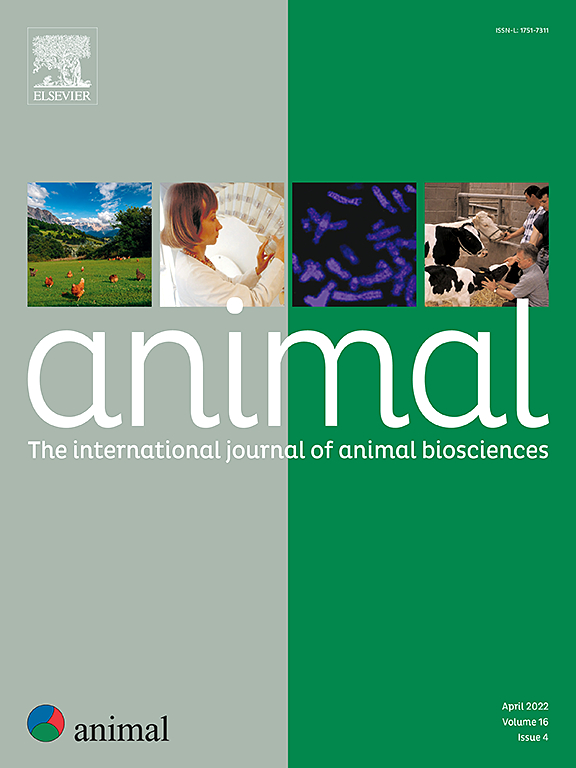Review: Intrauterine growth restriction, diagnosis and physiological characterisation in pigs
IF 4.2
2区 农林科学
Q1 AGRICULTURE, DAIRY & ANIMAL SCIENCE
引用次数: 0
Abstract
The economy of modern pig breeding programs relies largely on sow reproductive performance. Over the last decades, genetic selection in the sow breeding sector has focused on increasing the number of piglets born per litter. As a result, highly prolific sows now often give birth to 18–20 live piglets. However, in parallel with the improved prolificacy, there has been an increase in the number of piglets experiencing growth restriction during foetal development, a marked decline in the birth body weight (BtW) of the piglets, and an increase in perinatal mortality rates. Intrauterine growth restriction (IUGR) is defined as the inability of the foetus to achieve its expected growth potential during gestation. Insufficient space within the uterus represents a primary factor contributing to IUGR in highly prolific sows. Uterine overcrowding is indeed associated with reduced placental weight and decreased uterine blood flow per foetus. The impaired uteroplacental blood flow results in inadequate distribution of metabolic substrates to the foetus, which develops poorly. In this context, the supply of oxygen and nutrients to the vital organs is prioritised, leading to preserved brain development, often at the detriment of other organs like the liver and the small intestine. This adaptive mechanism, termed the “brain-sparing effect”, results in a relative increase in brain size compared to other organs. Therefore, an appropriate measure for assessing the severity of IUGR in piglets is the ratio between brain weight and the weight of other organs. However, since IUGR often results in low-BtW piglets with a distinctive head shape, the diagnosis is commonly based on the piglet BtW and/or head morphology due to their practical applicability, despite the risk of misclassification. Piglets affected by IUGR have insufficient energy reserves and display low vitality at birth. If they survive the neonatal period, they usually face higher morbidity and mortality, impaired growth, reduced nutrient efficiency, and delayed time to slaughter. The lack of an accurate diagnostic method for IUGR remains a major challenge, limiting the development of effective interventions. Given these reasons and the fact that IUGR piglets can constitute up to 30% of a litter, the impact of this condition on the pig production system is significant, leading to a decrease in overall production efficiency. This review aims to provide an updated overview of the physiological features, diagnostic challenges, and long-term consequences of IUGR in pigs, and to discuss potential approaches for improving early detection and management strategies.
综述:猪的宫内生长限制、诊断和生理特征
现代养猪项目的经济效益很大程度上依赖于母猪的繁殖性能。在过去的几十年里,母猪育种部门的遗传选择主要集中在增加每窝仔猪的出生数量上。因此,高产母猪现在通常产下18-20头活仔猪。然而,在繁殖能力提高的同时,在胎儿发育期间出现生长受限的仔猪数量增加,仔猪出生体重(BtW)显著下降,围产期死亡率增加。宫内生长受限(IUGR)被定义为胎儿在妊娠期间无法达到其预期的生长潜力。子宫内空间不足是导致高产母猪IUGR的主要因素。子宫过度拥挤确实与胎盘重量减少和每个胎儿子宫血流量减少有关。子宫胎盘血流受损导致代谢底物分配不足,胎儿发育不良。在这种情况下,重要器官的氧气和营养供应被优先考虑,导致大脑发育得到保护,通常会损害肝脏和小肠等其他器官。这种适应性机制被称为“脑保留效应”,与其他器官相比,导致大脑大小相对增加。因此,衡量仔猪IUGR严重程度的适当指标是脑重与其他器官重量之比。然而,由于IUGR通常会导致头型独特的低BtW仔猪,由于其实际适用性,通常根据仔猪BtW和/或头部形态进行诊断,尽管存在错误分类的风险。受IUGR影响的仔猪在出生时能量储备不足,活力低下。如果它们在新生儿期存活下来,它们通常会面临更高的发病率和死亡率、生长受损、营养效率降低和延迟屠宰时间。缺乏对IUGR的准确诊断方法仍然是一个主要挑战,限制了有效干预措施的发展。考虑到这些原因,以及IUGR仔猪可占窝产仔猪的30%,这种情况对养猪生产系统的影响是显著的,导致整体生产效率下降。本综述旨在提供猪IUGR的生理特征、诊断挑战和长期后果的最新概述,并讨论改进早期发现和管理策略的潜在方法。
本文章由计算机程序翻译,如有差异,请以英文原文为准。
求助全文
约1分钟内获得全文
求助全文
来源期刊

Animal
农林科学-奶制品与动物科学
CiteScore
7.50
自引率
2.80%
发文量
246
审稿时长
3 months
期刊介绍:
Editorial board
animal attracts the best research in animal biology and animal systems from across the spectrum of the agricultural, biomedical, and environmental sciences. It is the central element in an exciting collaboration between the British Society of Animal Science (BSAS), Institut National de la Recherche Agronomique (INRA) and the European Federation of Animal Science (EAAP) and represents a merging of three scientific journals: Animal Science; Animal Research; Reproduction, Nutrition, Development. animal publishes original cutting-edge research, ''hot'' topics and horizon-scanning reviews on animal-related aspects of the life sciences at the molecular, cellular, organ, whole animal and production system levels. The main subject areas include: breeding and genetics; nutrition; physiology and functional biology of systems; behaviour, health and welfare; farming systems, environmental impact and climate change; product quality, human health and well-being. Animal models and papers dealing with the integration of research between these topics and their impact on the environment and people are particularly welcome.
 求助内容:
求助内容: 应助结果提醒方式:
应助结果提醒方式:


